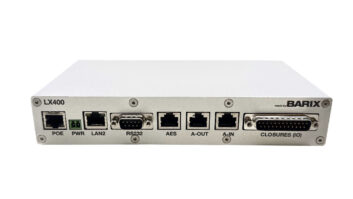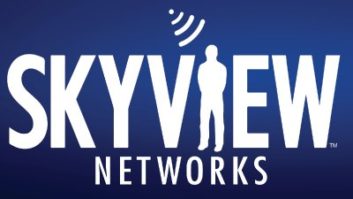Radio World publishes User Reports on products in various equipment classes throughout the year to help potential buyers understand why a colleague made a given equipment choice. These User Reports are unpaid testimonials written by users who have already purchased the gear. Radio World Product Evaluations, by contrast, are freelance articles by a paid reviewer who typically receives a demo loaner.
SCOTTSDALE, Ariz. — The broadcast industry increasingly views satellite and IP as competing signal delivery platforms. There rarely is press about how the cross-compatibility of the two platforms actually can enhance the way network programming is processed and distributed.
Skyview Networks specializes in news and sports program distribution for the radio industry, typically serving radio networks with multiple stations and affiliates. The satellite advantage allows Skyview to distribute program audio through the open air to stations across the United States, directly uplinking to SES World Skies AMC-8.
Play ball

Jeff Scott, executive news operations director, is shown in Skyview Networks’ studios in Scottsdale. Barix Instreamer 100 is on top of the right rack in the inset. Skyview increasingly has turned to IP for audio backhaul and confidence monitoring. The company has more than 20 ISDN lines that gradually will disappear in favor of IP. That will reduce monthly expenses vastly and offer nearly universal availability.
Much of the company’s confidence in IP is based on experience with Barix audio-over-IP equipment. Skyview has used Barix devices since 2004, relying on them more frequently as the many benefits became clear.
Software-based IP solutions have their value, especially when free of cost, but lack the stability and simplicity of Barix hardware. Skyview has found Barix encoding and decoding devices to be far more reliable with impressive features and functionality. The price point of the Instreamer encoders and Exstreamer decoders compared to other IP hardware devices clearly beats the competition, usually by two-to-one.
Recent success stories include the Caribbean World Series, a championship baseball series affiliated with the Winter League programs of Major League Baseball. Skyview distributed the 2009 and 2010 Series (Mexico and Venezuela, respectively) to several U.S. stations. In addition to being a dual-country or cross-continental success story, the project also serves as an ideal case study for the compatibility of satellite and IP technologies.
The indeterminate availability of ISDN and engineering assistance in both regions forced a change in strategy for signal acquisition. It was decided that IP would be an ideal distribution method following confirmation and evaluation of network connectivity.
Skyview configured a Barix Instreamer 100 to support 96 kbps audio (MPEG Layer III) at the encode point. The device was also preconfigured for firewall compatibility and set for DHCP address assignment, essentially creating a plug-and-play situation at the origination point.
The Instreamer encoded the audio for streaming to the Skyview facility in Scottsdale, Ariz., where an Exstreamer 100 received and decoded the signal. The Exstreamer was connected to a mixing console, the output of which was sent through a final audio processing stage before hitting the uplink.
The Instreamer and Exstreamer 100 units are designed with unbalanced audio inputs and outputs, so an audio interface was used at each end to convert to balanced audio to maintain quality throughout the audio chain. (We expect soon to test the Exstreamer 500, which has balanced inputs and outputs.)
In action
Two stations in the network did not have satellite dishes, presenting a final challenge. Rather than install expensive dishes (approximately $2K) and receivers (approximately $1K), a preconfigured Exstreamer was shipped to each station to receive the signal. Skyview used Instreamers to re-encode the audio from the console and deliver the signal to each station. There, the Exstreamers decoded the audio and sent it directly to the on-air consoles.
In a similar situation, Skyview distributes live Chicago Bulls National Basketball Association broadcasts to multiple stations. One station, WLTH(AM) in Merrillville, Ind., is incapable of adding a C Band dish at its site. A point-to-point Instreamer>Exstreamer pair was configured for this station so they can receive and broadcast each game.
The Barix devices are nothing if not versatile. Skyview is responsible for recording and logging the occurrence of live reads during play-by-play broadcasts for the San Diego Padres, Cleveland Indians, Pittsburgh Pirates and Los Angeles Clippers professional sports teams. These stations have online streams, but do not have the rights to stream these live professional sports events. Live read monitoring is accomplished using Barix Instreamers.
Skyview ships a preconfigured Instreamer to each station where the devices are connected to a console and the office network. The Instreamer encodes and streams the live feed to the Internet and Skyview technicians listen to the broadcasts from desktops in Scottsdale (or laptops from anywhere) using Winamp. The use of free software to monitor broadcasts further minimizes costs.
The continued reliability and versatility of Barix devices has been instrumental in Skyview’s increasing reliance on IP for audio backhaul, distribution and monitoring. It also makes a solid case for cross-compatibility with satellite networks.
The author is vice president of engineering with Skyview Networks.
Scott Boddicker, director of operations at Skyview Networks, also contributed to this article.
For information, contact Andy Stadheim at Barix in Minnesota at (866) 815-0866 or visitwww.barix.com.












